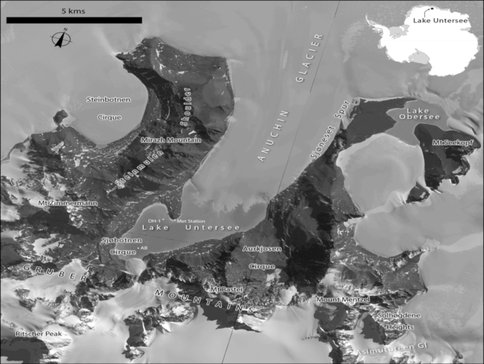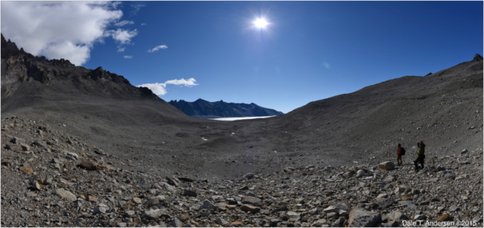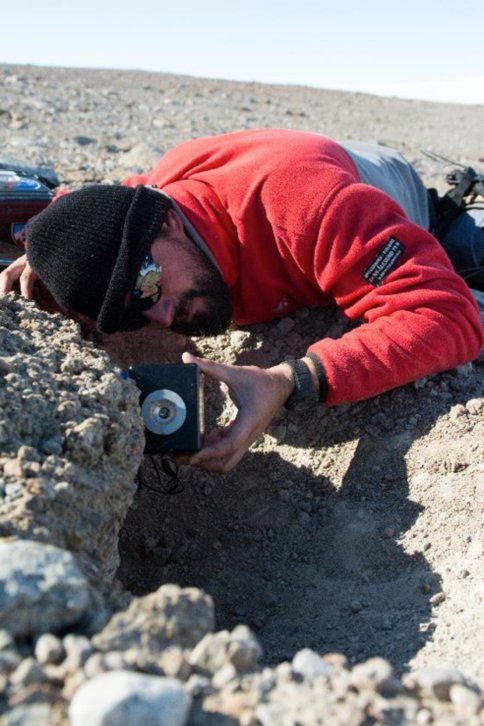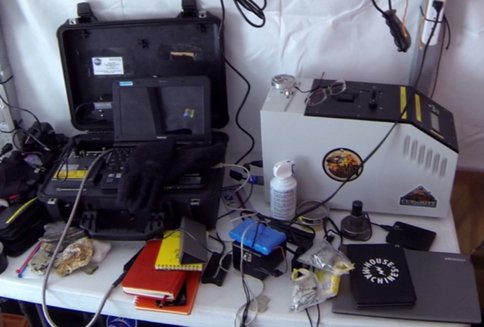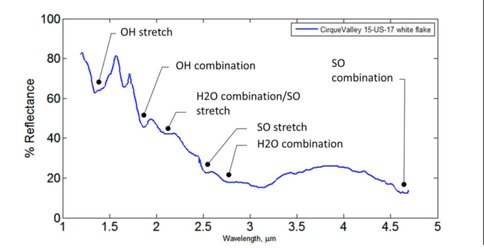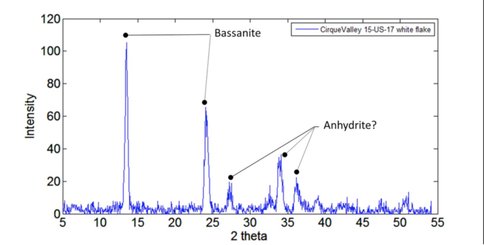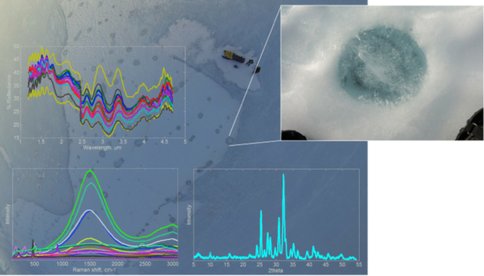2015 Annual Science Report
 SETI Institute
Reporting | JAN 2015 – DEC 2015
SETI Institute
Reporting | JAN 2015 – DEC 2015
Lake Sediment Habitats; Lake Habitability and Sediment Biosignatures
Project Summary
Regions where lakes and ponds existed once existed on Mars martian are among the highest priority environments for exploration. The physicochemical and biological characteristics of the unique of perennially ice-covered lake ecosystems found on earth in Antarctica, the High Arctic, and in high altitude environments (Altiplano and High Andes) serve as important analogs of earily Mars. Active and abundant microbial communities live in these extreme environments, suggesting the presence of habitable conditions on early on Mars. Unlike temperate lakes, these ecosystems are largely dominated and constrained by their physical environment (e.g., mean annual temperatures near or well below 0°C, with arid or hyper-arid conditions year-round). In these environments, lake sediments accumulate organic biosignatures due to relatively low metabolic rates and cold water. Less understood is their preservation potential once the water evaporates, and sediments are exposed to extreme cold and hyper-arid conditions. Perennially ice-covered lakes are rare on Earth. Their dry, paleo-counterparts are even more exotic, and biosignature preservation in such lake deposits remains largely unstudied. Lake Untersee, one of the largest perennially ice-covered surface lakes in East Antarctica hosts a robust microbial ecosystem including the presence of photosynthetic microbial mats that colonize the lake bottom to depths greater than 100m. These mats are primarily composed of filamentous cyanophytes and form two distinct macroscopic structures – cm-scale cuspate pinnacles dominated by Leptolyngbya spp. and laminated, large conical stromatolites that rise up to 0.5 m above the lake floor, dominated by Phormidium spp. (Andersen et al. 2011). Adjacent to Lake Untersee is the Aurkjosen Cirque, a basin that was once inundated by a large lake which has since evaporated. Desiccated, buried microbial mats have been recovered from this paleo- lacustrine site, and they provide material for the identification of biosignatures and their preservation in and extremely cold setting. Our investigations include the studies of the physical and biogeochemical characteristics of the two lakes, deposition and preservation of biomarkers, and in situ analytical techniques (IR reflectance, Raman, XRD/XRF) to identify organic signatures within a mineralogical context while developing synergistic operational concepts for in situ analyses in paleolake analogs.
Project Progress
In the fall of 2015 Andersen, Sobron and team members from Canada, Japan, Russia and Austria travelled to Lake Untersee in the mountains of Queen Maud Land, Antarctica to continue a series of studies aimed at understanding this interesting lake ecosystem, its sedimentary history, local climate, and to begin detailed investigations of a paleo-basin located to the east of the lake. This research involves living and working in a very remote, windy area of Antarctica for 6-8 weeks with no additional outside support once the camp is set up.
Lake Untersee is located in the Otto-von-Gruber-Gebirge (Gruber Mountains) of central Dronning Maud Land. The lake is 563 m above sea level, with an area of 11.4 km2 and is one of the largest surface lakes in East Antarctica. The lake has two sub-basins; the largest, 169 m deep, lies adjacent to the Anuchin Glacier and is separated by a sill at 50 m depth from a smaller, 100 m deep basin in the southwest corner. The deep basin is close to homothermal and well oxygenated to the bottom. In contrast, the shallow basin is density stratified below the sill depth (c. 50 m) and anoxic at its base (Wand et al. 1997, Andersen et al. 2011). Two extraordinary features of the lake are a high concentration of methane (>20 mmol/l) in the deep part of the anoxic basin and a pH of ≥10.4 in the mixed layer of the lake. The primary source of methane has been identified as microbial reduction of carbon dioxide using hydrogen. The high pH has been attributed to weathering of plagioclase supplied by anorthosite in the lake catchment, which produces high calcium, high pH, low DIC waters. The lake water column is clear and ultra-oligotrophic, with volumetric planktonic primary productivity close to the lowest on record. The floor of the lake is covered with photosynthetic microbial mats that colonize the lake bottom to depths greater than 100m. These mats are primarily composed of filamentous cyanophytes and form two distinct macroscopic structures – cm-scale cuspate pinnacles dominated by Leptolyngbya spp. and laminated, large conical stromatolites that rise up to 0.5 m above the lake floor, dominated by Phormidium spp. (Wand et al. 2006, Andersen et al. 2011).
Water sampling and profiling were undertaken from holes drilled through the ice cover (2.5 m to 4 m thick) in the two main basins of the lake. Conductivity, temperature, pH and dissolved oxygen were profiled using a freshly calibrated HydroLab DS5 multi-parameter datasonde rated to 200m. Water samples for major ions, nutrients, sulfide and planktonic chlorophyll-a analysis, and water isotopes were taken with a 2.2-L acrylic Kemmerer bottle. Penetration of photosynthetically active radiation (PAR) through the ice cover and water column were estimated using LI-Cor quantum sensors coupled to a LI-1500 light sensor logger.
Larger holes (1.5 m diameter) were melted through the ice to provide access to the lake for divers using SCUBA (e.g., Andersen 2007). This enabled observing, imaging and sampling the benthic photosynthetic microbial mats between between 4-40 m. Quantitative samples of the cohesive microbial mats for biomass estimation and pigment analysis were taken by coring through the mat, lifting it from the underlying sediments and placing it into a small tube that was then capped. Sediment cores for were collected by divers by driving a 50 or 100 mm diameter polycarbonate tube into the lake floor and sealing it with rubber stoppers. Core sections were sub-sampled and with some samples analyzed in-situ for organics, biomarkers, and associated geochemistry (e.g., lipids, carbon dating) and mineralogy and others being frozen for further laboratory investigations.
Local climate has been monitored at this site with an automatic weather station (AWS) since Dec of 2008 (Andersen et al. 2015) and we used this opportunity to download and collect the data stored in the AWS dataloggers. In the Aurkjosen Cirque we have initiated studies to reconstruct the glacial history which led to the formation of the basin and the large lake which once resided there.
The lake’s water level changed over time as well and this will be determined by mapping relic shorelines that are present. Of particular interest are the former lake sediments which have been preserved in perennially cold conditions. These sediments contain desiccated, buried microbial mats, a testament to an earlier aquatic ecosystem. Using ultra-clean sampling protocols samples of these sediments and mats have been collected and are being returned for analysis to characterize in detail the nature, structure, chemical composition, quantity and distribution of organic compounds and biomarkers (hydrocarbons and lipids) and associated isotopic analysis (13C, 14C).
We also deployed a Raman spectrometer, IR reflectance spectrometer, and an X-ray diffraction/fluorescence (XRD/XRD) spectrometer in the field. The objectives of our field investigation with these instruments are to: (1) Advance science readiness of instruments for planetary exploration, including life-detection instruments; (2) Define, test, and validate concepts of operation for the in-situ characterization of organics, biomarkers, and associated geochemistry and mineralogy at Mars analog sites; (3) Inform the collection of samples for further laboratory investigations.
We analyzed lake ice, glacier ice, sediments from glacial cryoconites, organic-rich sediments from the paleolake basin, and organic-rich lake sediments from aerobic and anaerobic basins of Lake Untersee. As we submit this report, we are curating the data and starting to interpret the field data. We have collected samples from Lake Untersee and the surrounding area and have had them shipped them back to our various home institutions either frozen or properly preserved. While we have yet to receive the samples, once we do we will share subsamples with the NAI SETI team for subsequent analysis with laboratory instruments.
References
Andersen, D. T., C. P. McKay, and V. Lagun (2015), Climate Conditions at Perennially Ice-Covered Lake Untersee, East Antarctica, Journal of Applied Meteorology and Climatology, 54(7), 1393-1412, doi:10.1175/jamc-d-14-0251.1.
Andersen, D. T., D. Y. Sumner, I. Hawes, J. Webster-Brown, and C. P. McKay (2011), Discovery of large conical stromatolites in Lake Untersee, Antarctica, Geobiology, 9(3), 280-293, doi:10.1111/j.1472-4669.2011.00279.x.
Andersen DT (2007) Antarctic inland waters: scientific diving in the perennially ice-covered lakes of the McMurdo Dry Valleys and Bun- ger Hills. In Proceedings of the International Polar Diving Workshop (eds Lang MA, Sayer MDJ). Smithsonian Institution, Washington, DC, pp. 163–170.
Wand U, Samarkin V, Nitzsche H, Hubberten H (2006) Biogeo- chemistry of methane in the permanently ice-covered Lake Unter- see, central Dronning Maud Land, East Antarctica. Limnology and Oceanography 51, 1180–1194.
Wand U, Schwarz G, Brüggemann E, Bräuer K. (1997) Evidence for physical and chemical stratification in Lake Untersee (central DronningMaud Land, East Antarctica). Antarctic Science 9:43–45.
Publications
-
Andersen, D. T., McKay, C. P., & Lagun, V. (2015). Climate Conditions at Perennially Ice-Covered Lake Untersee, East Antarctica. Journal of Applied Meteorology and Climatology, 54(7), 1393–1412. doi:10.1175/jamc-d-14-0251.1
-
Koo, H., Strope, B. M., Kim, E. H., Shabani, A. M., Kumar, R., Crowley, M. R., … Bej, A. K. (2016). Draft Genome Sequence of Janthinobacterium sp. Ant5-2-1, Isolated from Proglacial Lake Podprudnoye in the Schirmacher Oasis of East Antarctica. Genome Announc., 4(1), e01600–15. doi:10.1128/genomea.01600-15
-
Steel, H. C. B., McKay, C. P., & Andersen, D. T. (2015). Modeling circulation and seasonal fluctuations in perennially ice-covered and ice-walled Lake Untersee, Antarctica. Limnology and Oceanography, 60(4), 1139–1155. doi:10.1002/lno.10086
-
PROJECT INVESTIGATORS:
-
PROJECT MEMBERS:
Pablo Sobrón
Co-Investigator
Wayne Pollard
Collaborator
-
RELATED OBJECTIVES:
Objective 2.1
Mars exploration.
Objective 4.1
Earth's early biosphere.
Objective 7.1
Biosignatures to be sought in Solar System materials
